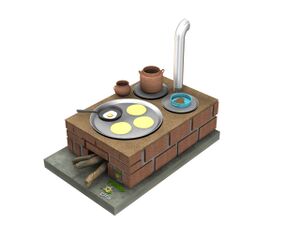Patsari Cookstove

The Patsari Cookstove, an improved cook stove is an adaption and improvement of the Lorena Cookstove which has been in use in Guatemala and Mexico since the early 1990's. It is designed and distributed by the Interdisciplinary Group of Rural and Appropriate Technology (GIRA) located in Patzcuaro, Michoacan, Mexico. In comparison to the Lorena, several improvements have been incorporated into the design of the Patsari including:
- The exterior is made of brick in order to lengthen the lifetime
- Molds are used in the construction process in order to guarantee the proper dimensions of the combustion chamber for standardization
- A highly optimized combustion chamber
- Secondary burners that maximize heat transfer to multiple cooking surfaces
- Baffles redirect hot gases to the secondary burners
- The heating surfaces (comales) are sealed to prevent smoke from entering the living area
- A prefabricated chimney base that facilitates ease of cleaning
Patsari means "the one who takes care of" in the Patzcuaro Lake regions indigenous people's Purhe'pecha language; the stove is designed to take care of the health of the users as well as the global environment. Some of the benefits of using the stove are:
- 50% reduction in fuel consumption compared to an open fire
- 66% reduction in indoor air concentration of particulate matter and poisonous gases (CO) compared to an open fire
Dissemination Program[edit | edit source]
The Patsari cookstove dissemination program managed by GIRA is part of a new generation of cookstove programs. Having learned from previous programs' successes and failures, the Patsari Project aims to address a range of complementary issues including:
- Conservation of forest resources
- Improving indoor air quality
- Reducing household expenditures on fuel
- Reducing the global impacts resulting from the emissions of greenhouse gases and black carbon
The program is working on the assumption that to be successful it must incorporate more than merely the fabrication and distribution of improved stoves. The Patsari Project addresses the whole cooking system and the stove adoption process, recognizing that all the benefits from the stoves strongly depend on their sustained use. This is an integrated approach that addresses several interrelated components simultaneously including:
- Technology innovation
- Creative financing and market development
- Monitoring of the actual health and environmental impacts
- Monitoring of stove adoption, sustained use and maintenance
Construction[edit | edit source]
For design specifications and step-by-step construction instructions please refer to the Patsari Cookstove Construction Manual (in Spanish).
References[edit | edit source]
- Omar Masera, Rodolfo Diaz, Victor Berrueta. 2005. From cookstoves to cooking systems: the integrated program on sustainable household energy use in Mexico. Energy for Sustainable Development.
- Omar Masera, Rufus Edwards, Cynthia Armendáriz Arnez, Victor Berrueta, Michael Johnson, Leonora Rojas Bracho, Horacio Riojas-Rodríguez, Kirk R. Smith. June 2007. Impact of Patsari improved cookstoves on indoor air quality in Michoacan, Mexico. Energy for Sustainable Development, Elsevier


















































